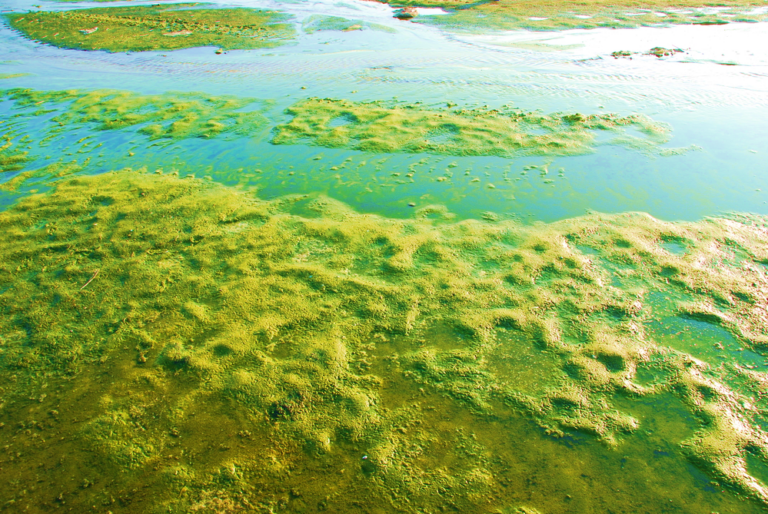The serene allure of a pond can be disrupted by the unwelcome intrusion of string algae, posing a common challenge for pond enthusiasts. String algae, characterized by its slimy, green strands, has the potential to compromise both the aesthetic appeal and ecological balance of ponds.
Table of Contents
WHAT IS STRING ALGAE?
String algae, often referred to as filamentous algae, are long, slimy strands of algae that can form dense, unsightly mats in ponds. These algae thrive in nutrient-rich water and are characterized by their stringy appearance, often resembling green hair. While some algae are a natural and essential part of pond ecosystems, an overgrowth of string algae in ponds can disrupt the balance, affecting both the aesthetics and health of the pond.
IS STRING ALGAE GOOD FOR PONDS?
Contrary to any potential misconceptions, an abundance of string algae is not beneficial for ponds. While a moderate amount of algae can contribute to a pond’s ecosystem by providing oxygen and serving as a food source for certain organisms, an excessive presence of string algae can lead to several issues. It can deplete oxygen levels, block sunlight from reaching submerged plants, and create an unsightly appearance that detracts from the overall beauty of the pond.
HOW DO YOU TREAT STRING ALGAE IN PONDS?
Several effective methods exist for treating string algae in ponds, ranging from manual removal to the use of chemical treatments:
Manual Removal: Physically removing string algae is a straightforward yet time-consuming method. Use a pond skimmer or rake to pull the strands out of the water. While this approach provides immediate relief, it may not address the root cause of the issue.
Algaecides: Algaecides are chemical treatments designed to control algae growth. Copper-based algaecides are commonly used to target string algae. It’s crucial to follow application guidelines carefully to prevent harm to other aquatic life in the pond.
Barley Straw: Barley straw is a natural and eco-friendly solution for controlling string algae. As it breaks down, it releases compounds that impede the growth of algae. Place straw bundles in the pond, allowing them to gradually break down and provide ongoing control.
Aeration: Enhancing pond aeration can disrupt the conditions favorable for string algae. Installing an aerator increases oxygen levels and promotes a healthier pond environment, reducing the likelihood of algae overgrowth.
WHAT WILL HAPPEN IF YOU DO NOT TREAT STRING ALGAE IN PONDS?
If left untreated, the proliferation of string algae in ponds can result in a series of detrimental consequences that significantly impact the overall health and appeal of the ecosystem. One critical concern is oxygen depletion; as string algae rapidly multiply, they form dense mats that obstruct sunlight and impede the exchange of oxygen. When these algae die and decompose, they consume oxygen during the process, potentially leading to oxygen depletion and jeopardizing the well-being of fish and other aquatic life within the pond.
Furthermore, the overgrowth of string algae can upset the delicate balance of the pond’s ecosystem, outcompeting other aquatic plants for essential resources. This disruption can have cascading effects, influencing the habitat and biodiversity of both plant and animal life. The aesthetic charm of the pond is not spared either, as the green, tangled mess created by string algae diminishes the once serene beauty, diminishing the enjoyment for both pond owners and those who appreciate its natural allure.
Additionally, neglecting the treatment of string algae contributes to water quality issues. The decomposition of excessive string algae releases compounds that degrade water quality, leading to murky water, unpleasant odors, and an overall decline in the pond’s aquatic environment.
In essence, failing to address the overgrowth of string algae is a recipe for a compromised ecosystem, with ramifications that extend from the vitality of aquatic life to the aesthetic pleasure derived from the pond. Therefore, proactive measures and effective treatments are crucial to preserve the balance, health, and visual appeal of ponds, ensuring they remain vibrant and inviting aquatic sanctuaries.
CONCLUSION:
In the fight against string algae in ponds, understanding its nature and implementing effective treatment methods is essential for maintaining a healthy and visually pleasing aquatic environment. Whether opting for manual removal, algaecides, barley straw, or aeration, addressing string algae promptly is crucial to prevent potential consequences that can harm the pond’s ecosystem. By taking proactive measures and staying vigilant, pond enthusiasts can ensure that their aquatic retreat remains a thriving and picturesque haven for both flora and fauna.

